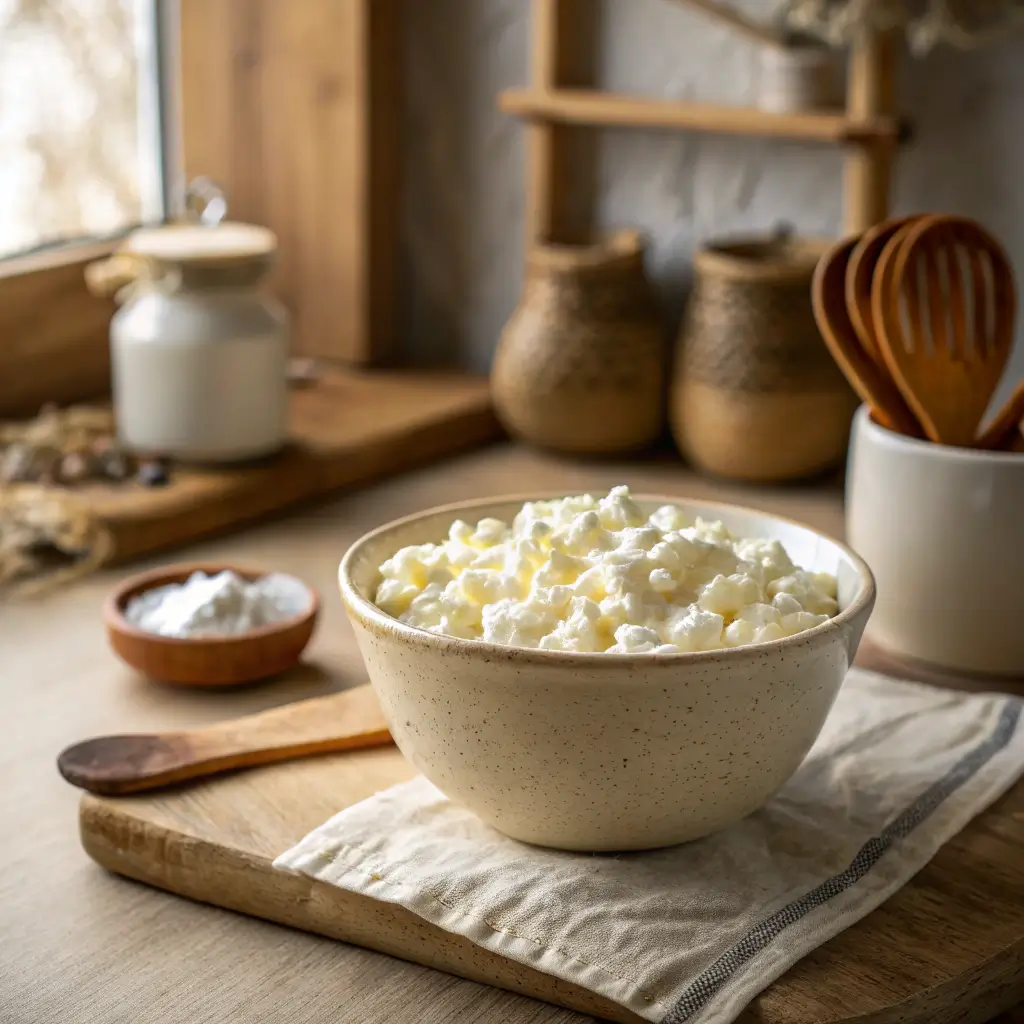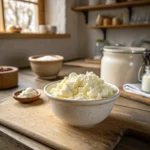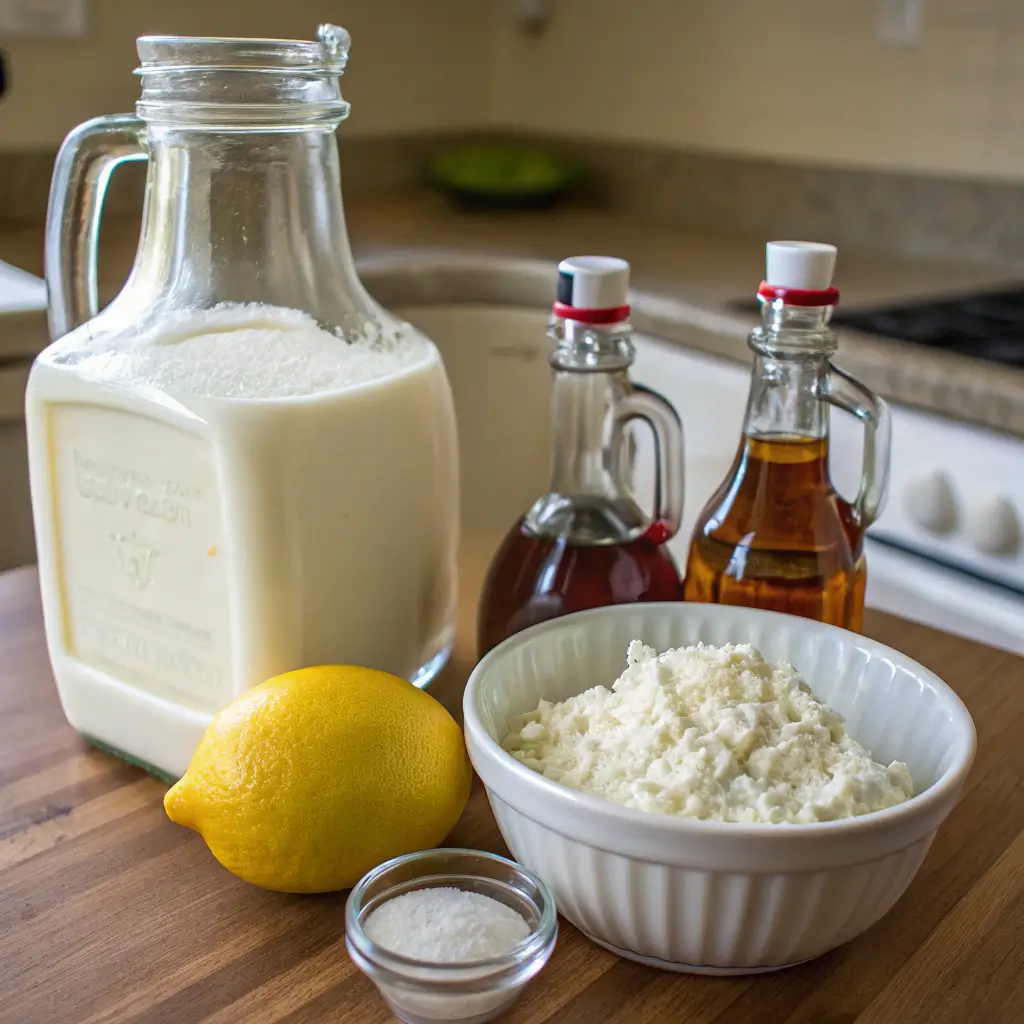
Homemade cottage cheese is the perfect way to enjoy fresh, wholesome dairy without added preservatives or mystery ingredients. Whether you’re cutting down on sodium, following a high-protein diet, or just love cooking from scratch, making this creamy, nutrient-rich cheese at home is easier than you think. In this guide, you’ll learn every step of the process—from what milk to use, to how much cheese you’ll yield per gallon. We’ll also compare it with store-bought options and explore fun, healthy ways to enjoy your batch. Let’s dive into the world of real, homemade flavor—starting with why this choice is worth it.
Table of Contents
Table of Contents
Why Homemade Cottage Cheese Is Better Than Store-Bought
Health Benefits of Homemade Cottage Cheese
When you make homemade cottage cheese, you’re skipping the additives that come with store-bought brands. Most packaged cottage cheeses contain preservatives, stabilizers, and high levels of sodium. But when you make it yourself, you’re in full control. You choose the milk. You set the salt level. You avoid all the fillers. For people on heart-healthy, low-sodium, or whole-food diets, that’s a major win.
Homemade versions also offer more nutrients per serving. Since it’s made fresh, you get maximum protein and healthy fats—especially if you use full-fat milk or add cream after curdling. It’s naturally gluten-free, low in carbs, and rich in calcium.
The Flavor and Freshness Advantage
Let’s be honest—store-bought cottage cheese often tastes bland or overly processed. Homemade cottage cheese is creamier, fresher, and more flavorful. You’ll actually enjoy eating it plain, or even as a topping for fruit, toast, or baked potatoes.
The DIY process is simple and rewarding. From heating the milk to watching it curdle, the transformation is satisfying. And best of all? You can adjust the texture, saltiness, and cream level exactly to your liking.
Print
Homemade Cottage Cheese
- Total Time: 30 minutes
- Yield: 1.5 to 2 pounds
Description
Creamy, protein-rich, and preservative-free—this homemade cottage cheese is your go-to for fresh, wholesome dairy made right in your kitchen.
Ingredients
- 1 gallon fresh whole milk (avoid ultra-pasteurized)
- 1/2 cup distilled white vinegar or lemon juice
- Salt to taste (optional)
- 2–4 tablespoons heavy cream (optional, for creamier texture)
Instructions
- Pour milk into a heavy-bottomed pot and heat slowly over medium heat to 190°F, stirring occasionally.
- Remove from heat and stir in vinegar or lemon juice gently.
- Let sit undisturbed for 10 minutes until curds form.
- Line a colander with cheesecloth and pour in the mixture to separate curds and whey.
- Tie cheesecloth corners and let drain 5–10 minutes depending on desired moisture level.
- Rinse curds under cold water and gently squeeze out excess liquid.
- Transfer curds to a bowl and stir in cream and salt to taste, if using.
Notes
Avoid ultra-pasteurized milk, and don’t rush heating—slow and steady makes perfect curds.
- Prep Time: 10 minutes
- Cook Time: 20 minutes
- Category: Dairy
- Method: Stovetop
- Cuisine: Homemade
What You Need to Make Homemade Cottage Cheese at Home
Simple Ingredients for Homemade Cottage Cheese

To start making homemade cottage cheese, you only need a few basic ingredients. The simplicity is part of the charm. Here’s what you’ll need:
- 1 gallon of fresh milk – Whole milk gives the best curds, but you can also use 2% if you prefer a lighter version. Avoid ultra-pasteurized milk, which may not curdle properly.
- Acid source – You can use distilled white vinegar or lemon juice to separate the curds from the whey. Each brings a slightly different tang.
- Salt (optional) – A small pinch can bring out the natural flavors, but you control the amount—or skip it entirely.
- Cream (optional) – For a rich, creamy texture, add a spoonful of heavy cream after the curds are rinsed.
That’s it. No strange chemicals or hard-to-pronounce thickeners.
Kitchen Tools for Homemade Cheese Success
You don’t need fancy gear to make homemade cottage cheese, but the right tools make it easier:
- Heavy-bottomed pot – Helps heat the milk evenly without scorching.
- Thermometer – While not essential, it helps you track when the milk reaches the ideal temperature (around 190°F).
- Slotted spoon – For scooping the curds gently without breaking them.
- Fine mesh strainer or cheesecloth – This is key for separating and rinsing the curds.
- Bowl and ladle – For mixing, draining, and serving.
Looking for inspiration? Try this 5-ingredient guide that keeps things easy in the kitchen.
Once you gather your ingredients and tools, you’re ready to move on to the cheese-making magic.
Step-by-Step Process to Make Homemade Cottage Cheese
Heating and Curdling the Milk
Making homemade cottage cheese starts with warming the milk—slowly and carefully. Pour one gallon of fresh whole milk into a heavy-bottomed pot. Over medium heat, warm it gradually to about 190°F, just before boiling. Stir occasionally to avoid burning. Once it reaches temperature, remove from heat.
Next, add your acid. For most home kitchens, ½ cup of white vinegar or lemon juice works well. Stir gently. You’ll see the milk begin to separate—curds forming and whey turning yellowish-clear. This moment is pure magic.
Let the mixture sit undisturbed for 10 minutes. The curds will continue to firm up as they rest.
Draining, Rinsing, and Creaming the Curds
After curds have formed, line a colander with cheesecloth and precisely pour the contents through. The curds will remain in the cloth, while the whey drains down. Tie up the corners of the cloth and let it drain further for 5–10 minutes, depending on how dry or moist you prefer your cheese.
Once drained, rinse the curds under cold water to cool them down and remove excess acidity. Gently squeeze out any remaining liquid.
At this stage, your homemade cottage cheese is ready—but for extra richness, transfer it to a bowl and stir in a few tablespoons of heavy cream. This gives it that classic, creamy texture.
Taste and adjust with a pinch of salt if desired.
Looking for a cozy way to use it? Don’t miss our upcoming ideas in Part 9 for delicious recipes using your fresh batch.
Common Mistakes When Making Homemade Cottage Cheese
Why Your Homemade Cottage Cheese May Not Form Properly
Even though making homemade cottage cheese is simple, a few easy-to-miss mistakes can throw off the entire batch. One of the most common issues is curds not forming. This usually happens when the milk isn’t heated enough or is heated too fast. For best results, always bring the milk slowly to about 190°F. Rushing this step can lead to poor separation.
Another culprit? Using ultra-pasteurized milk. This type of milk has been hotted to a high temperature that damages the proteins demanded for ripening. If you’re unsure, check the label—opt for pasteurized or raw milk if allowed in your area.
Adding acid too early or too late also affects curd quality. Wait until the milk is fully heated before introducing lemon juice or vinegar, then stir gently and let it sit undisturbed.
Fixing Texture, Taste, and Moisture Problems
Is your homemade cottage cheese too dry? You may have drained it too long or squeezed too hard. The good news? You can fix it by mixing in a bit of cream or whole milk to restore softness and richness.
If it tastes too sour, it could be due to using too much vinegar or letting it sit too long after adding the acid. Next time, start with a smaller amount and taste as you go.
On the flip side, if your cheese is too bland, try a sprinkle of sea salt or add fresh herbs like chives or parsley.
How to Flavor and Customize Homemade Cottage Cheese

Savory Add-Ins for Homemade Cottage Cheese
One of the best perks of making homemade cottage cheese is the freedom to flavor it exactly how you like. If you’re a fan of savory snacks or protein-packed lunches, consider mixing in fresh or dried herbs, spices, or vegetables.
Try these tasty savory combinations:
- Chopped chives and cracked black pepper
- Garlic powder with sun-dried tomatoes
- Smoked paprika and roasted bell peppers
- Cucumber and dill for a refreshing crunch
These variations turn your cottage cheese into a gourmet dip, sandwich spread, or protein-rich topping. You can also add a splash of olive oil or lemon zest to brighten up the flavor without overpowering the cheese’s creamy base.
For low-sodium diets, opt for salt-free spice blends to keep things flavorful and heart-healthy.
Sweet Variations to Satisfy Your Cravings
Homemade cottage cheese isn’t just for savory lovers—it can be a sweet treat, too. Its neutral base pairs beautifully with fruits, nuts, and natural sweeteners.
Here are some delicious ideas:
- Sliced peaches with a drizzle of honey
- Strawberries and slivered almonds
- Pineapple chunks and toasted coconut
- Cinnamon, raisins, and a touch of maple syrup
You can enjoy these mixes as a healthy dessert, a quick breakfast, or even as a post-workout snack. Plus, adding fruits and nuts boosts the nutritional value with fiber, antioxidants, and healthy fats.
Don’t miss our next section where we compare costs—so you’ll know exactly how much you’re saving with every flavorful batch of your homemade creation.
Frequently Asked Questions About Homemade Cottage Cheese
How do I make cottage cheese from scratch?
To make homemade cottage cheese, heat one gallon of milk to about 190°F, then stir in an acid like lemon juice or white vinegar. Let it sit for 10 minutes until curds form. Drain the curds using a cheesecloth, rinse under cold water, and add a bit of cream and salt if desired. That’s it—simple, fresh, and totally customizable.
Is it cheaper to make your own cottage cheese?
Yes, making homemade cottage cheese is typically cheaper than buying it at the store—especially if you buy milk in bulk. For example, one gallon of milk (often less than $4) can yield about 1.5 pounds of cottage cheese, which would cost more than double if bought pre-made. Plus, you save on additives and packaging waste.
How much cottage cheese does 1 gallon of milk make?
One gallon of milk generally produces about 1.5 to 2 pounds of homemade cottage cheese, depending on how much liquid is drained and whether cream is added. Whole milk typically yields the richest, largest volume of curds.
Is homemade cottage cheese better?
Absolutely. Homemade cottage cheese is fresher, free from preservatives, and easily adjustable to your taste. You can control the salt, the creaminess, and even the texture. It’s a cleaner, more natural option for anyone focused on nutrition, flavor, or food transparency.
Conclusion: Why You Should Try Making Homemade Cottage Cheese Today
If you’re tired of bland, overpriced, store-bought options, it’s time to give homemade cottage cheese a try. Not only is it incredibly easy to make, but it’s also more affordable, customizable, and far more delicious. You control every ingredient—from the type of milk to the flavor profile. Whether you’re eating clean, cutting costs, or just love real food, homemade cottage cheese delivers.
Don’t miss our comfort food collection and dairy-based kitchen guides on Easy Cook Today to continue your journey into fresh, nourishing cooking.
For more recipes, follow us on Facebook.
